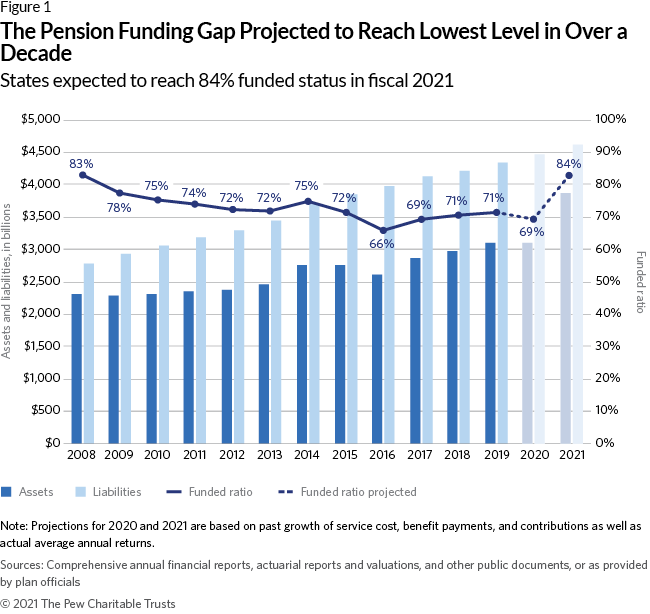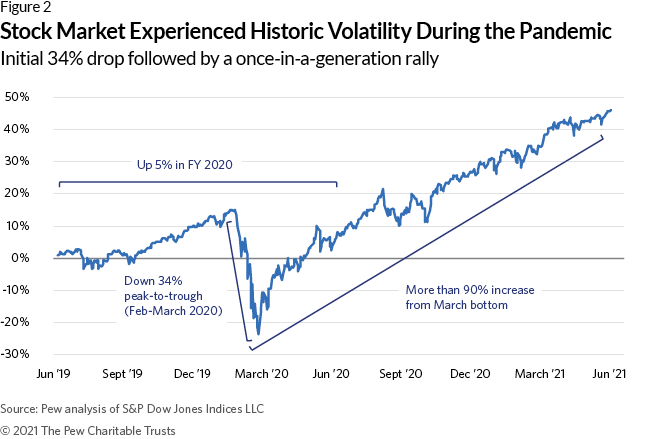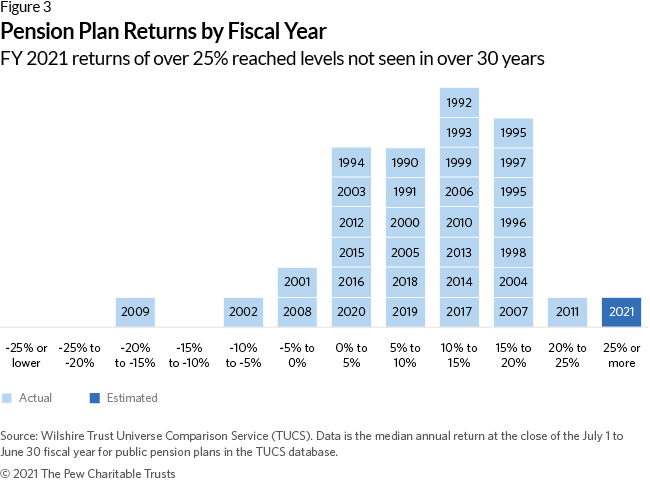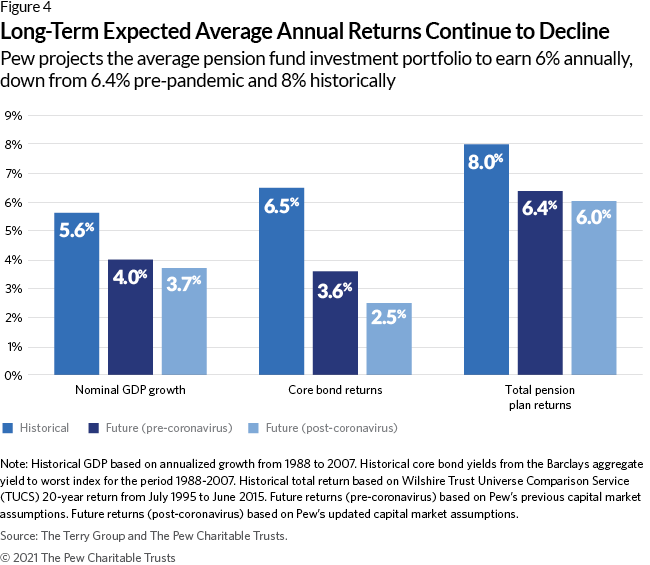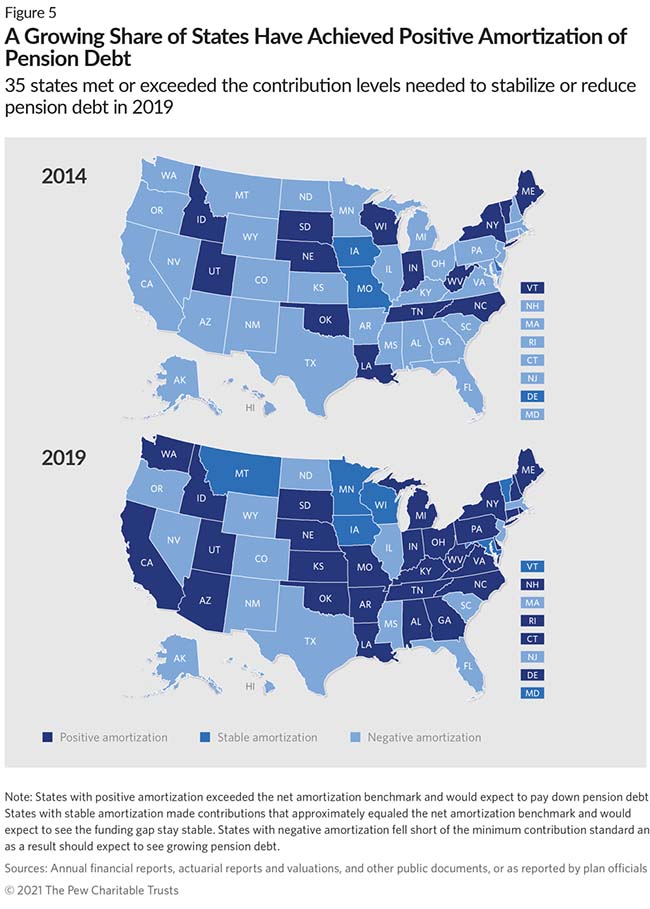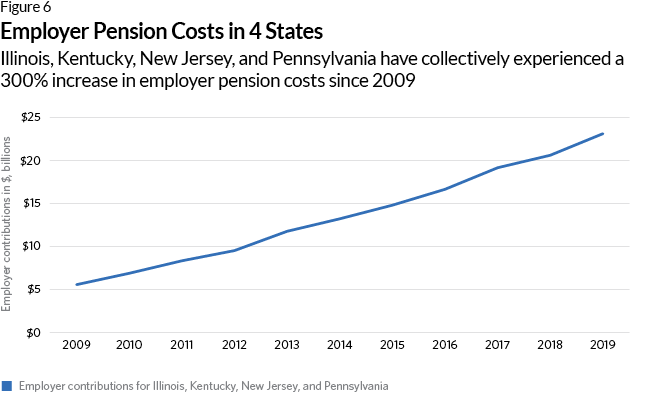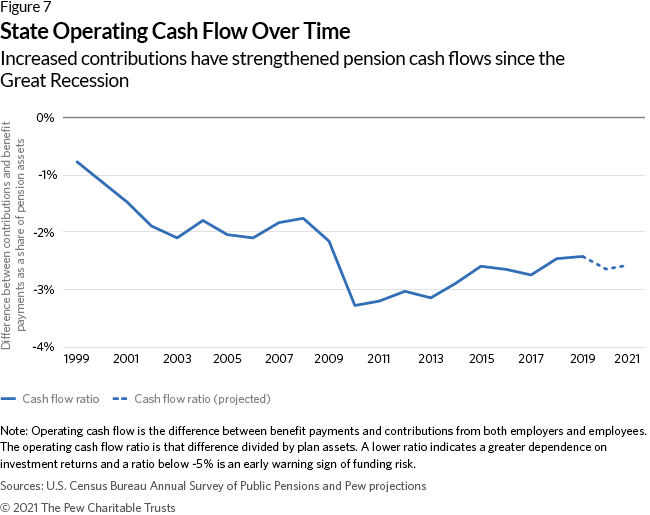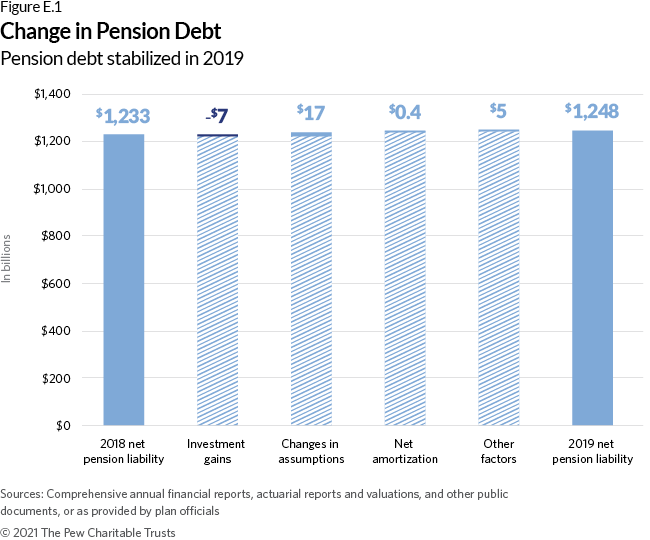The State Pension Funding Gap: Plans Have Stabilized in Wake of Pandemic
Increased contributions and a market surge have strengthened balance sheets, but uncertainty remains

Overview
The nation’s state retirement systems finished the 2021 fiscal year in their best condition since the Great Recession of 2007-09. According to projections by The Pew Charitable Trusts, the gap between the cost of pension benefits that states have promised their workers and what they have set aside to pay for them dropped in 2021 to its lowest level in more than a decade. Pew estimates that state retirement systems are now over 80% funded for the first time since 2008.
Such progress would be significant in any year, but the improvement in fiscal 2021 occurred during a recession in which many analysts predicted that revenue losses related to the COVID-19 pandemic would increase retirement fund shortfalls. Instead, Pew found an increase in assets of over half a trillion dollars in state retirement plans, fueled by market investment returns of more than 25 percent in fiscal 2021 (the highest annual returns for public funds in over 30 years) and substantial increases in contributions from taxpayers and public employees to pension funds.
These contribution increases, which came after years of states shortchanging their systems, are part of an upward trend over the past 10 years. Pew research shows that contributions have increased an average of 8% each year over the past decade, boosting assets and paying down debt. In the four states with the most financially troubled pension systems—Illinois, Kentucky, Pennsylvania, and New Jersey—contributions increased by an average of 16% a year over the same period.
Nearly every state has also enacted benefit reforms to lower costs, including cutting benefits for newly hired public workers. Officials in many states have also become more disciplined about managing pension finances, using tools such as stress testing to determine how twists and turns in the economy might affect pension funds.
As a result, Pew found that for the first time this century, states are expected to have collectively met the minimum pension contribution standard.1 This means that even before the market rally during the pandemic, payments into state pension funds were sufficient to cover current benefits and reduce pension debt, a milestone called positive amortization.
The improvement in pension funding levels also has led to the highest aggregate funding ratio since the 2007-09 recession. Based on data from the fiscal year that ended June 30 in most states, Pew estimates that the funded ratio—the dollars held in pension funds compared to dollars promised in retiree benefits—has risen above 80%, a substantial improvement.
In landmark research published in 2010, Pew identified a sizable funding gap between what states had promised their retirees and what they had put aside preceding the recession—a gap that ultimately grew to over $1 trillion by 2015. Using the June 30, 2021, returns, Pew now projects the gap, or unfunded liability, could fall below $1 trillion due to a combination of policymaker efforts and windfall investment returns.
Despite the encouraging trend, public pension funding can be volatile. Even before the pandemic, many economists were forecasting slower growth and lower long-term investment returns compared to past business cycles, which could trigger a need for states to raise their pension fund contributions to make up the shortfall. For states already paying down large pension debts—retirement system costs in some states eat up more than 15% of state revenue—further contribution increases may be difficult to fund without cutting essential services and programs or raising taxes.
To continue to pay promised benefits while reducing pension debt, state policymakers must employ strategies to keep up with scheduled contributions—which is easier to accomplish with a plan to address future uncertainty. Successful state pension systems, such as those in Wisconsin, South Dakota, and Tennessee, have maintained high funded ratios over the past 20 years in part because they have strategies—including policies that target debt reduction and share gains and losses with workers and retirees—to mitigate cost increases during economic downturns.
Key Terms and Concepts
Assumed rate of return: The expected rate that a pension fund estimates its investments will return based on forecasts of economic growth, inflation, and interest rates. Decreasing a plan’s assumed rate of return leads to higher calculated liabilities.
Employer contribution: State pension plans are typically funded by contributions from participating employers, which can include not only the state itself but local governments, public universities, school districts, and other government entities. In most public pension plans, employees contribute as well.
Funded ratio: The value of a plan’s assets in proportion to the pension liability. This is an annual point-in-time measure as of the reporting date. Pew’s analysis applies the market value of assets and the pension liability as reported by states under current government accounting standards.
Net amortization benchmark: The amount of contributions from employers and plan sponsors that would be sufficient to keep unfunded liabilities from increasing if all actuarial assumptions—primarily investment expectations—were met for a given year. The benchmark is calculated as the cost of new benefits earned in a year plus the interest on the pension debt minus expected employee contributions.
Pension debt: Current-year pension debt is calculated as the difference between the total value of pension benefits owed to current and retired employees or dependents and the plan assets on hand. Pension plans with assets greater than accrued liabilities show a surplus.
Risk-sharing features: Formal mechanisms that allocate risk and/or distribute unexpected costs among employers, employees, and retirees, typically through variable benefit or contribution arrangements (also referred to as cost sharing).
State pension plans estimated to exceed 80% funded status
State retirement systems showed signs of stabilization in 2019, meaning that growth in unfunded liabilities, or pension debt, had slowed or reversed. And given the once-in-a-generation investment returns over the past 18 months, preliminary projections show that pension plans are anticipated to be more than 80% funded in 2021, a level higher than any point since the 2007-09 recession. As a result, Pew projects that state retirement systems will have less than $1 trillion in accumulated pension debt for the first time since 2014.
Overall, state plans ended the 2019 fiscal year with an estimated liability of $4.35 trillion and $3.10 trillion in assets, leaving a $1.25 trillion funding gap and a funded ratio of 71%. These results are essentially unchanged from fiscal 2018. Employer contributions totaled $115 billion in 2019, which represents a $4 billion increase from 2018. This data represents the most up-to-date comprehensive figures reported by state pension plans.
Since the fiscal 2019 reporting period ended, an unprecedented $5 trillion in federal stimulus and other government interventions have buoyed financial markets and strengthened plan balance sheets.2 As a result, state plans earned returns of over 25% in fiscal 2021—a highwater mark not seen since the 1980s. Pew estimates that total unfunded liabilities dropped below $1 trillion by the end of fiscal 2021, which would push state plans to be more than 80% funded for the first time since 2008. (See Figure 1; for more detail, see also Appendix G.) The significant improvement in plans’ fiscal position is due in large part to dramatic increases in employer contributions to state pension funds in the past decade, which boosted assets by more than $200 billion. Since 2010, annual contributions to state pensions have increased by 8% annually, twice the rate of revenue growth. And for the 10 lowest-funded states, the yearly growth in employer contributions averaged 15% over this period. As a result, after decades of underfunding and market losses from risky investment strategies, for the first time this century states are expected to have collectively achieved positive amortization in 2020—meaning that payments into state pension funds were sufficient to pay for current benefits as well as reduce pension debt.
An increase in pension contributions of the size seen over the past decade signals a shift in budget priorities by state policymakers and a recognition that the costs of postponing obligations are untenable if left unaddressed. Although this has improved the outlook for state pension plans, it has also crowded out spending on other important programs and services and left states with less budgetary space to sustain future rises in pension payments.
Surge in market returns has improved pension funded levels
Stocks waged a historic recovery by the end of fiscal 2020, more than offsetting the 34% decline in market prices earlier in the year at the onset of the pandemic. (See Figure 2.) The average state pension fund earned 3% for the fiscal year ending June 30, 2020, avoiding losses but yielding returns well below targets. Since then, the market has experienced a once-in-a-generation rally. On average, plans earned investment returns of over 25% for fiscal 2021, which translates into gains above expectations of more than half a trillion dollars.
Most analysts attribute the strong market performance to historically low interest rates and an unprecedented $5 trillion in federal stimulus in response to the pandemic. In addition, the economy is now recovering at a rapid pace, with recent projections by the Congressional Budget Office, Moody’s, and the Federal Reserve forecasting a return to pre-pandemic levels of gross domestic product by calendar year 2022 or before.3
However, the path to recovery remains uncertain, and the long-term forecast for economic growth and pension investment returns is less rosy. The Congressional Budget Office expects average real economic growth of 1.6% between 2026 and 2031 and nominal growth of 3.7% over the same time frame—significantly lower than the historical average.4 As such, market experts now estimate equity returns, which are related to economic growth and current market value of stocks, to be 6.4% over the long term, compared with 6.7% before the pandemic.5 And with interest rates currently lower than pre-pandemic levels, they also project bonds to yield just 2% over the next decade before returning to the pre-pandemic expected yield of about 4%.6
Since pension funds hold about 50% of their assets in stocks and 25% in bonds,7 these downward adjustments to the outlook for these asset classes mean that we expect the typical pension fund to return approximately 6% annually over the next 20 years. This is significantly lower than historical long-term returns of 8% (see Figure 4), and a full percentage point lower than the current average assumed rate of return for state-sponsored retirement funds of around 7%. The difference of 1 percentage point yield on the $3 trillion in assets held by state pension funds equates to a reduction in anticipated investment income of $30 billion annually and highlights the importance of continuing to make annual scheduled payments to pension plans.
Net amortization improvements reflect growing contribution rates
In 2019, states were on the cusp of meeting minimum contribution standards—measured using the net amortization benchmark—for the first time this century, and preliminary 2020 data suggests that this benchmark was met that year. Pew measures the adequacy of state pension contributions by comparing employer pension payments to a net amortization benchmark, calculated as the amount needed to keep pension debt from growing, assuming investment returns hit their target. In 2014, when Pew first introduced this measure, only 17 states met or exceeded the benchmark; overall, states fell short of the metric by $28 billion. Five years later, the 2019 data reveals that 35 states achieved the minimum contribution standard, with the remaining 15 states accounting for a deficiency of less than $1 billion.
This improvement is the culmination of dramatic increases in pension payments over the past decade. Employer contributions grew by 8% annually from 2008 to 2019—about twice as fast as growth in state revenue over the same period.
Illinois, Kentucky, New Jersey, and Pennsylvania led this trend in increasing contributions, with an average growth in scheduled pension payments of 16% each year from 2009 to 2019. These states have been among the worst-funded states for two decades, and their contribution increases are part of long-term plans to address the large legacy pension debt each has accumulated. As a result, Kentucky and Pennsylvania achieved positive amortization in 2019, with Illinois and New Jersey expected to begin reducing pension debt once the outsized investment returns in fiscal 2021 are recognized. In each case, the turnaround was prompted by state policymakers’ acknowledgment that a return to pension plan funding discipline—paying down pension debts in addition to the value of annual benefits as they are earned—is the only path forward in order to avoid pension fund insolvency.
Funding discipline has been central to the improvement in these states, though all four have also changed benefits to help reduce future costs and risks. Illinois began its long path to pension funding in 1995, with a plan to be 90% funded by 2045. This approach was criticized for pushing costs to future generations of taxpayers, as evidenced by the sharp increase in contributions required between 2008 and 2019. However, a quarter of a century later, Illinois is getting closer to stabilizing pension debt, though plan actuaries continue to encourage further strengthening funding policy.
In 2000, Kentucky, New Jersey, and Pennsylvania reported having fully funded pension plans, in contrast to Illinois. But those three states emerged as among the worst-funded due to a combination of shortchanging contributions, offering unfunded benefit increases, and investments that fell short of expectations. All of these weaknesses were in place before 2008. When the 2007-09 recession hit, it further strained underfunded pension systems and forced a reckoning.
In all three states, the initial response to the recession was to gradually increase the level of pension payments that would avoid immediate budget pressures but would give policymakers a plan to meet minimum funding standards. In Kentucky, it became clear that this would take too long. In 2013, further reforms required the state to start making the full payment recommended by plan actuaries and put in place a new plan design to help manage risk. Pennsylvania stuck with the ramp up in pension costs despite the strain it placed on state and school budgets. In 2017, state officials supplemented the initial response with changes to plan design for new hires to make future costs more predictable and lowered investment fees expected to save taxpayers at least $3 billion. New Jersey was the slowest to fulfill its promise to make full pension payments. Before the pandemic, the strategy was to make the full payment in the fiscal 2023 budget, but an improved fiscal situation allowed policymakers to put the full pension payment in the 2022 budget, a year ahead of schedule and the first time this century New Jersey will meet minimum funding standards.
Cash flow ratio shows improvement for at-risk states
Net amortization is used to assess whether a state’s contributions to its pension plans are sufficient to pay down debt if all plan assumptions are met. Given the volatility of market returns, however, Pew also assesses the ratio of operating cash flow to assets, which measures the minimum investment return necessary to keep asset levels steady from year to year.
State pension funds typically exhibit negative operating cash flow—the difference between contribution inflows and benefit payment outflows—which is not uncommon for a mature pension plan. An aging workforce magnifies this trend. For example, benefit payments grew by an annualized rate of 9% between 2000 and 2007, as Baby Boomers began to retire in greater numbers. As operating cash flow declines, lower-than-expected investment performance is more likely to cause a drop in plan assets, which makes it harder for plans to generate returns in the future.
And when the absolute value of the operating cash flow ratio exceeds the assumed rate of return, plan managers can expect assets to decline over time—with the possibility of insolvency if the trend is not halted. For plans with very low funding levels, growing negative ratios can heighten concerns about having enough cash to pay retirees. In general, a ratio below negative 5% is a source of concern, because in a low-return environment the plan could be required to liquidate its assets to keep up with benefit payments.
In the aggregate, state pension plans’ cash flow ratio has improved over the past decade—from approximately minus 3.3% in 2010 to minus 2.4% in 2019—as a result of the dramatic increase in contributions to state pension plans over the same period. The shift has been particularly significant in states with poorly funded plans, some of which have recently ramped up contributions significantly.
For example, public pension plans in Colorado, Ohio, Oregon, New Jersey, and Rhode Island reported operating cash flow ratios below minus 5% in 2017. However, as a result of sustained increases in contributions and other recent policy changes, all 50 states reported cash flows of higher than minus 5% of assets as of 2019. For the first time since financial reports included comparable cash flow metrics in 2014, no state is currently reporting a ratio under minus 5%, reflecting a significant reduction in the risk of declining assets or plan insolvency across the 50 states.
Plan finances have stabilized but states must plan for uncertainty
For the first time since the 2007-09 recession, state pension plans stabilized in fiscal 2020, meaning states are expected to have collectively achieved positive amortization. Public plans, including severely underfunded plans in Kentucky and Pennsylvania, are now making annual contributions that would be sufficient, if maintained as a percentage of revenue, to fund projected benefit payments over the long term without further increases—if investment return targets averaging 7% and other plan assumptions are met.
However, these results do not factor in the real-world market volatility that has been a source of losses and unpredictable increased costs for public pension plans in the past. For this reason, states must not only maintain fiscal discipline targeting the reduction of pension debt over time but also adopt and follow policies to manage the uncertainty of future volatile returns and costs.
Pew’s past research has detailed a number of the tools used by states to manage uncertainty while offering secure retirement benefits to public employees. These include robust funding policies,8 plan designs that share gains and losses with workers and retirees,9 and stress testing10 to measure the impact of risks on pension plan balance sheets and government budgets. Providing policymakers with traditional metrics such as funded ratio and annual employer contributions in combination with forward-looking information on pension plan cash flows and cost volatility would aid them as they assess current policies and determine if changes are necessary.
Conclusion
Events over the past 18 months highlight the volatility and uncertainty facing state pension plans. For a decade now, state governments have taken important steps to strengthen their pension plans by increasing contributions, adopting changes to plan provisions, and reducing assumed rates of return. This, in combination with federal policies to help states offset revenue losses and stimulate the broader economy to withstand the impact of COVID-19, has mitigated the impact of the pandemic on plan balance sheets and employer costs.
In fact, state retirement systems are in a stronger financial position than at any time since the 2007-09 recession.
However, with required pension contributions at historic highs, states are facing continued long-run uncertainty. Policymakers can continue to plan for this uncertainty by regularly evaluating the adequacy of plan policies, contributions, and assumptions to improve and maintain pension plan fiscal stability while keeping promises to workers.
Appendix A: Methodology
All figures presented are as reported in public documents or as provided by plan officials. The main data sources used were the annual financial reports produced by each state and pension plan, actuarial reports and valuations, and other state documents that disclose financial details about public employment retirement systems. Pew collected data for more than 230 pension plans.
Pew shared the collected data with plan officials to give them an opportunity to review them and to provide additional information. This feedback was incorporated into the data presented in this brief.
Because of lags in valuation for many state pension plans, only partial 2020 data was available, and fiscal 2019 is the most recent year for which comprehensive data was available for all 50 states. Data on a subset of California local governments participating in the California Public Employees’ Retirement System was not available in aggregate and was not included in our data.
Each state retirement system uses different key assumptions and methods in presenting its financial information.
Pew made no adjustments or changes to the presentation of aggregate state asset or liability data for this brief. Assumptions underlying each state’s funding data include the assumed rate of return on investments and estimates of employees’ life spans, retirement ages, salary growth, marriage rates, retention rates, and other demographic characteristics.
While 2019 is the latest year in which data reported by state pension plans is comprehensively available, Pew does project estimates of state pension funding using the reported data already collected, growth trends of benefit payments, cost of new benefits, contributions, and actual returns. This allows for an estimate of how financial market performance will strengthen or weaken plan funding before full valuation data is complete and made publicly available.
Appendix B: State data, 2019
In thousands
(Note: Additional columns can be viewed by scrolling to the right.)
| State | Assets (plan net position) | Liabilities (total pension liability) | Pension debt (net pension liability) | Funded ratio |
|---|---|---|---|---|
| Alabama | $38,500,462 | $55,493,692 | $16,993,230 | 69.4% |
| Alaska | $15,225,378 | $22,601,647 | $7,376,269 | 67.4% |
| Arizona | $49,918,471 | $76,603,446 | $26,684,975 | 65.2% |
| Arkansas | $28,566,045 | $35,710,507 | $7,144,463 | 80.0% |
| California | $474,320,399 | $659,379,791 | $185,059,392 | 71.9% |
| Colorado | $51,777,882 | $77,902,629 | $26,124,747 | 66.5% |
| Connecticut | $32,005,074 | $72,130,302 | $40,125,228 | 44.4% |
| Delaware | $10,209,477 | $12,238,003 | $2,028,526 | 83.4% |
| Florida | $163,875,771 | $209,503,378 | $45,627,607 | 78.2% |
| Georgia | $95,648,351 | $121,560,635 | $25,912,284 | 78.7% |
| Hawaii | $17,227,027 | $31,396,448 | $14,169,421 | 54.9% |
| Idaho | $17,748,987 | $18,766,401 | $1,017,414 | 94.6% |
| Illinois | $92,604,849 | $237,926,328 | $145,321,479 | 38.9% |
| Indiana | $30,781,301 | $44,873,026 | $14,091,725 | 68.6% |
| Iowa | $34,766,448 | $40,729,723 | $5,963,275 | 85.4% |
| Kansas | $20,648,054 | $29,548,688 | $8,900,634 | 69.9% |
| Kentucky | $23,983,779 | $53,726,295 | $29,742,516 | 44.6% |
| Louisiana | $36,765,936 | $54,945,690 | $18,179,754 | 66.9% |
| Maine | $15,075,606 | $17,884,427 | $2,808,821 | 84.3% |
| Maryland | $54,265,724 | $75,823,728 | $21,558,004 | 71.6% |
| Massachusetts | $58,300,776 | $98,149,000 | $39,848,224 | 59.4% |
| Michigan | $65,031,418 | $106,444,668 | $41,413,250 | 61.1% |
| Minnesota | $70,827,689 | $86,137,051 | $15,309,362 | 82.2% |
| Mississippi | $28,591,376 | $46,362,581 | $17,771,205 | 61.7% |
| Missouri | $59,867,756 | $76,967,416 | $17,099,660 | 77.8% |
| Montana | $11,865,792 | $16,367,578 | $4,501,786 | 72.5% |
| Nebraska | $15,200,208 | $16,318,610 | $1,118,402 | 93.1% |
| Nevada | $44,284,253 | $57,920,216 | $13,635,963 | 76.5% |
| New Hampshire | $9,225,823 | $14,081,489 | $4,855,666 | 65.5% |
| New Jersey | $82,293,100 | $207,123,469 | $124,830,369 | 39.7% |
| New Mexico | $29,247,630 | $43,446,645 | $14,199,015 | 67.3% |
| New York | $215,169,161 | $223,931,529 | $8,762,368 | 96.1% |
| North Carolina | $101,374,184 | $114,617,668 | $13,243,484 | 88.4% |
| North Dakota | $5,891,521 | $8,435,276 | $2,543,755 | 69.8% |
| Ohio | $168,358,904 | $210,472,683 | $42,113,778 | 80.0% |
| Oklahoma | $33,177,918 | $41,097,735 | $7,919,817 | 80.7% |
| Oregon | $70,203,700 | $87,501,200 | $17,297,500 | 80.2% |
| Pennsylvania | $89,829,884 | $154,790,492 | $64,960,608 | 58.0% |
| Rhode Island | $6,587,825 | $12,098,031 | $5,510,206 | 54.5% |
| South Carolina | $32,285,963 | $58,290,622 | $26,004,659 | 55.4% |
| South Dakota | $12,472,800 | $12,462,202 | -$10,597 | 100.1% |
| Tennessee | $41,114,643 | $41,849,388 | $734,745 | 98.2% |
| Texas | $186,844,393 | $270,698,862 | $83,854,469 | 69.0% |
| Utah | $35,198,555 | $38,396,056 | $3,197,501 | 91.7% |
| Vermont | $4,523,424 | $7,098,882 | $2,575,458 | 63.7% |
| Virginia | $79,790,715 | $103,345,496 | $23,554,781 | 77.2% |
| Washington | $100,940,648 | $104,779,685 | $3,839,037 | 96.3% |
| West Virginia | $15,933,768 | $19,111,458 | $3,177,690 | 83.4% |
| Wisconsin | $112,092,758 | $108,868,302 | -$3,224,456 | 103.0% |
| Wyoming | $9,040,667 | $11,811,074 | $2,770,407 | 76.5% |
| Total | $3,099,482,273 | $4,347,720,147 | $1,248,237,875 | 71.3% |
Sources: Comprehensive annual financial reports, actuarial reports and valuations, and other public documents, or as provided by plan officials
© 2021 The Pew Charitable Trusts
Appendix C: Net amortization details, 2019
In thousands
| State | Beginning of year net pension liability | Discount rate* | Assumed interest due on 2019 beginning of year debt | 2019 normal cost† | 2019 total expected cost‡ | 2019 employee contributions with interest | 2019 employer contribution benchmark§ | 2019 actual employer contributions with interest | Percent of employer benchmark paid | Net amortization|| |
|---|---|---|---|---|---|---|---|---|---|---|
| Alabama | $15,228,842 | 7.70% | $1,172,556 | $970,824 | $2,143,380 | $810,977 | $1,332,396 | $1,406,103 | 106% | $73,708 |
| Alaska | $6,929,243 | 8.00% | $554,232 | $224,768 | $779,000 | $120,743 | $658,421 | $617,082 | 94% | -$41,339 |
| Arizona | $25,215,806 | 7.47% | $1,884,052 | $1,734,608 | $3,618,660 | $1,418,794 | $2,195,730 | $2,342,724 | 107% | $146,994 |
| Arkansas | $6,508,389 | 7.32% | $476,523 | $548,342 | $1,024,865 | $226,075 | $734,707 | $796,771 | 108% | $62,064 |
| California | $179,954,479 | 7.11% | $12,789,499 | $14,035,633 | $26,825,132 | $6,922,256 | $19,828,823 | $22,106,732 | 111% | $2,277,909 |
| Colorado | $31,507,099 | 7.25% | $2,284,265 | $1,139,446 | $3,423,711 | $915,167 | $2,508,543 | $2,050,134 | 82% | -$458,409 |
| Connecticut | $35,070,959 | 7.42% | $2,602,385 | $866,772 | $3,469,157 | $828,911 | $2,602,562 | $3,003,609 | 115% | $401,047 |
| Delaware | $1,761,069 | 6.90% | $121,515 | $241,569 | $363,084 | $85,184 | $267,989 | $337,338 | 126% | $69,349 |
| Florida | $40,704,631 | 6.83% | $2,781,147 | $2,755,188 | $5,536,336 | $778,915 | $4,494,315 | $3,773,345 | 84% | -$720,971 |
| Georgia | $22,961,895 | 7.45% | $1,709,773 | $1,733,986 | $3,443,759 | $841,141 | $2,604,077 | $3,426,738 | 132% | $822,661 |
| Hawaii | $13,318,993 | 7.00% | $932,330 | $619,504 | $1,551,834 | $2,544 | $1,549,290 | $1,234,463 | 80% | -$314,828 |
| Idaho | $1,380,532 | 7.05% | $97,328 | $464,824 | $562,152 | $266,778 | $295,374 | $412,511 | 140% | $117,138 |
| Illinois | $140,593,161 | 6.88% | $9,675,431 | $3,433,869 | $13,109,301 | $1,587,671 | $11,520,552 | $8,927,232 | 77% | -$2,593,320 |
| Indiana | $14,571,271 | 6.75% | $983,561 | $607,101 | $1,590,662 | $66,858 | $1,523,803 | $2,204,743 | 145% | $680,940 |
| Iowa | $6,481,626 | 7.01% | $454,157 | $901,765 | $1,355,922 | $544,637 | $811,431 | $830,044 | 102% | $18,613 |
| Kansas | $8,900,507 | 7.75% | $689,789 | $563,297 | $1,253,086 | $453,984 | $799,102 | $1,182,204 | 148% | $383,102 |
| Kentucky | $28,603,572 | 6.74% | $1,928,680 | $771,301 | $2,699,981 | $453,468 | $2,134,081 | $2,354,111 | 110% | $220,029 |
| Louisiana | $17,591,031 | 7.61% | $1,338,257 | $726,630 | $2,064,887 | $551,176 | $1,515,456 | $2,232,223 | 147% | $716,767 |
| Maine | $2,665,534 | 6.75% | $179,924 | $304,986 | $484,910 | $208,486 | $276,423 | $427,963 | 155% | $151,540 |
| Maryland | $21,954,935 | 7.40% | $1,624,599 | $1,394,784 | $3,019,383 | $839,896 | $2,162,012 | $2,171,758 | 100% | $9,746 |
| Massachusetts | $36,941,268 | 7.35% | $2,715,183 | $1,846,862 | $4,562,045 | $1,465,563 | $3,059,541 | $2,877,796 | 94% | -$181,745 |
| Michigan | $37,602,952 | 7.03% | $2,645,231 | $871,353 | $3,516,584 | $450,945 | $3,065,656 | $3,556,043 | 116% | $490,387 |
| Minnesota | $15,188,717 | 7.49% | $1,138,171 | $1,540,625 | $2,678,796 | $1,201,710 | $1,472,661 | $1,498,116 | 102% | $25,455 |
| Mississippi | $16,806,359 | 7.75% | $1,302,493 | $704,407 | $2,006,900 | $605,684 | $1,401,216 | $1,098,241 | 78% | -$302,975 |
| Missouri | $16,635,517 | 7.41% | $1,232,402 | $1,279,208 | $2,511,610 | $962,501 | $1,538,787 | $1,648,894 | 107% | $110,107 |
| Montana | $4,381,723 | 7.59% | $332,730 | $248,775 | $581,505 | $214,850 | $366,343 | $366,980 | 100% | $638 |
| Nebraska | $1,526,977 | 7.50% | $114,523 | $370,072 | $484,596 | $257,047 | $227,549 | $331,897 | 146% | $104,348 |
| Nevada | $13,637,742 | 7.50% | $1,022,831 | $1,169,698 | $2,192,529 | $1,103,050 | $1,089,479 | $1,001,071 | 92% | -$88,407 |
| New Hampshire | $4,852,683 | 7.25% | $351,626 | $279,301 | $630,927 | $232,788 | $398,117 | $456,831 | 115% | $58,713 |
| New Jersey | $130,717,090 | 5.50% | $7,186,271 | $4,309,282 | $11,495,554 | $2,259,822 | $9,072,013 | $5,512,920 | 61% | -$3,559,093 |
| New Mexico | $18,166,479 | 6.41% | $1,164,326 | $934,953 | $2,099,279 | $606,028 | $1,458,747 | $776,646 | 53% | -$682,101 |
| New York | $4,238,202 | 7.00% | $296,674 | $3,932,033 | $4,228,707 | $399,818 | $3,828,889 | $4,907,551 | 128% | $1,078,663 |
| North Carolina | $12,509,924 | 7.00% | $875,580 | $2,609,477 | $3,485,057 | $1,427,670 | $2,058,040 | $2,590,165 | 126% | $532,126 |
| North Dakota | $3,030,258 | 6.96% | $210,861 | $252,828 | $463,689 | $167,706 | $296,404 | $186,753 | 63% | -$109,650 |
| Ohio | $50,018,512 | 7.31% | $3,655,013 | $3,147,905 | $6,802,918 | $3,159,977 | $3,644,931 | $3,908,259 | 107% | $263,328 |
| Oklahoma | $7,397,857 | 7.37% | $545,533 | $769,898 | $1,315,431 | $472,429 | $851,501 | $1,400,049 | 164% | $548,547 |
| Oregon | $15,148,600 | 7.20% | $1,090,699 | $1,146,400 | $2,237,099 | $11,803 | $2,225,296 | $1,781,051 | 80% | -$444,245 |
| Pennsylvania | $68,835,965 | 7.25% | $4,990,607 | $2,903,417 | $7,894,024 | $1,521,364 | $6,372,660 | $6,837,674 | 107% | $465,013 |
| Rhode Island | $5,481,096 | 6.99% | $383,352 | $154,005 | $537,358 | $96,617 | $440,384 | $460,243 | 105% | $19,859 |
| South Carolina | $25,465,724 | 7.25% | $1,846,265 | $1,165,147 | $3,011,412 | $1,065,041 | $1,946,371 | $1,876,669 | 96% | -$69,702 |
| South Dakota | -$2,332 | 6.50% | -$152 | $233,802 | $233,651 | $131,532 | $102,119 | $131,653 | 129% | $29,534 |
| Tennessee | $1,101,554 | 7.25% | $79,863 | $653,192 | $733,055 | $277,356 | $455,699 | $849,636 | 186% | $393,937 |
| Texas | $76,472,542 | 6.66% | $5,096,422 | $7,079,268 | $12,175,690 | $4,331,425 | $7,755,750 | $4,396,172 | 57% | -$3,359,579 |
| Utah | $5,448,659 | 6.95% | $378,682 | $670,791 | $1,049,473 | $34,380 | $1,017,394 | $1,284,420 | 126% | $267,026 |
| Vermont | $2,418,440 | 7.50% | $181,383 | $122,456 | $303,840 | $103,341 | $200,498 | $206,928 | 103% | $6,430 |
| Virginia | $20,337,887 | 7.00% | $1,423,652 | $1,907,883 | $3,331,535 | $910,918 | $2,420,617 | $2,539,984 | 105% | $119,367 |
| Washington | $6,070,331 | 7.40% | $448,970 | $2,131,796 | $2,580,766 | $1,176,509 | $1,401,975 | $3,134,842 | 224% | $1,732,868 |
| West Virginia | $3,357,120 | 7.50% | $251,784 | $273,102 | $524,886 | $173,628 | $351,258 | $673,879 | 192% | $322,622 |
| Wisconsin | $3,557,687 | 7.00% | $249,038 | $1,902,508 | $2,151,546 | $1,021,646 | $1,129,901 | $1,082,965 | 96% | -$46,935 |
| Wyoming | $3,642,608 | 6.83% | $248,641 | $231,821 | $480,461 | $187,243 | $289,709 | $189,364 | 65% | -$100,345 |
(Additional columns can be viewed by scrolling to the right.)
Notes: Numbers may not be exact due to rounding.
* The assumed rate of return is weighted for the plans in each state by the liability at the beginning of 2019.
† The normal cost refers to the estimated cost of benefits earned by employees in any given year. Also called the service cost.
‡ The total expected cost represents the projected increase in the funding gap before taking employer and employee contributions into account. It is equal to the normal cost plus the assumed interest on the unfunded liability.
§ The employer contribution benchmark is the contribution level employers need to meet in order to keep pension debt from growing.
|| For net amortization, positive numbers mean expected progress in paying down pension debt. Negative numbers mean expected growth in pension debt.
Sources: Comprehensive annual financial reports, actuarial reports and valuations, and other public documents, or as provided by plan officials
© 2021 The Pew Charitable Trusts
Appendix D: Details of changes to net pension liability, 2019
In thousands
| State | Beginning of year net pension liability | End of year net pension liability | Total changes | Net amortization benchmark | Employer and other contributions with interest | Net amortization | Change to reconcile | Investment experience | Benefit changes | Actuarial experience | Actuarial changes |
|---|---|---|---|---|---|---|---|---|---|---|---|
| Alabama | $15,228,842 | $16,993,230 | $1,764,388 | $1,332,396 | $1,406,103 | $73,708 | $1,838,096 | $2,044,588 | $0 | -$206,492 | $0 |
| Alaska | $6,929,243 | $7,376,269 | $447,027 | $658,421 | $617,082 | -$41,339 | $405,688 | $331,340 | $0 | -$403,546 | $477,894 |
| Arizona | $25,215,806 | $26,684,975 | $1,469,169 | $2,195,730 | $2,342,724 | $146,994 | $1,616,163 | $841,509 | $0 | $335,176 | $439,478 |
| Arkansas | $6,508,389 | $7,144,463 | $636,073 | $734,707 | $796,771 | $62,064 | $698,137 | $736,098 | -$21,462 | $199,558 | -$216,056 |
| California | $179,954,479 | $185,059,392 | $5,104,913 | $19,828,823 | $22,106,732 | $2,277,909 | $7,382,822 | -$927,551 | $33,283 | $1,823,146 | $6,453,943 |
| Colorado | $31,507,099 | $26,124,747 | -$5,382,352 | $2,508,543 | $2,050,134 | -$458,409 | -$5,840,761 | -$5,620,247 | -$1,554,402 | $1,333,888 | $0 |
| Connecticut | $35,070,959 | $40,125,228 | $5,054,269 | $2,602,562 | $3,003,609 | $401,047 | $5,455,316 | $557,162 | -$224,281 | $1,246,439 | $3,875,996 |
| Delaware | $1,761,069 | $2,028,526 | $267,457 | $267,989 | $337,338 | $69,349 | $336,806 | $253,043 | -$3,120 | $73,235 | $13,648 |
| Florida | $40,704,631 | $45,627,607 | $4,922,976 | $4,494,315 | $3,773,345 | -$720,971 | $4,202,006 | $1,841,411 | $11,404 | $247,482 | $2,101,709 |
| Georgia | $22,961,895 | $25,912,284 | $2,950,389 | $2,604,077 | $3,426,738 | $822,661 | $3,773,050 | $749,739 | $84,278 | $550,676 | $2,388,357 |
| Hawaii | $13,318,993 | $14,169,421 | $850,427 | $1,549,290 | $1,234,463 | -$314,828 | $535,600 | $253,806 | $0 | $221,473 | $60,320 |
| Idaho | $1,380,532 | $1,017,414 | -$363,118 | $295,374 | $412,511 | $117,138 | -$245,981 | -$133,534 | $0 | -$112,446 | $0 |
| Illinois | $140,593,161 | $145,321,479 | $4,728,318 | $11,520,552 | $8,927,232 | -$2,593,320 | $2,134,998 | $1,398,902 | -$462,610 | $530,276 | $668,430 |
| Indiana | $14,571,271 | $14,091,725 | -$479,546 | $1,523,803 | $2,204,743 | $680,940 | $201,394 | -$73,710 | $172,947 | $103,670 | -$1,513 |
| Iowa | $6,481,626 | $5,963,275 | -$518,351 | $811,431 | $830,044 | $18,613 | -$499,738 | -$368,132 | $0 | -$131,606 | $0 |
| Kansas | $8,900,507 | $8,900,634 | $127 | $799,102 | $1,182,204 | $383,102 | $383,229 | $307,788 | $0 | $75,441 | $0 |
| Kentucky | $28,603,572 | $29,742,516 | $1,138,944 | $2,134,081 | $2,354,111 | $220,029 | $1,358,973 | $387,915 | $0 | $183,426 | $787,632 |
| Louisiana | $17,591,031 | $18,179,754 | $588,724 | $1,515,456 | $2,232,223 | $716,767 | $1,305,491 | $969,814 | $876 | -$46,663 | $381,464 |
| Maine | $2,665,534 | $2,808,821 | $143,287 | $276,423 | $427,963 | $151,540 | $294,827 | $39,272 | $0 | $255,555 | $0 |
| Maryland | $21,954,935 | $21,558,004 | -$396,931 | $2,162,012 | $2,171,758 | $9,746 | -$387,185 | $612,535 | -$203 | -$260,116 | -$739,401 |
| Massachusetts | $36,941,268 | $39,848,224 | $2,906,956 | $3,059,541 | $2,877,796 | -$181,745 | $2,725,211 | $1,360,235 | $0 | $353,976 | $1,011,000 |
| Michigan | $37,602,952 | $41,413,250 | $3,810,298 | $3,065,656 | $3,556,043 | $490,387 | $4,300,685 | $1,293,738 | $5,252 | $161,417 | $2,840,277 |
| Minnesota | $15,188,717 | $15,309,362 | $120,645 | $1,472,661 | $1,498,116 | $25,455 | $146,100 | $202,472 | $0 | $79,172 | -$135,544 |
| Mississippi | $16,806,359 | $17,771,205 | $964,846 | $1,401,216 | $1,098,241 | -$302,975 | $661,871 | $428,200 | $0 | $0 | $233,671 |
| Missouri | $16,635,517 | $17,099,660 | $464,143 | $1,538,787 | $1,648,894 | $110,107 | $574,250 | $788,305 | $0 | -$293,420 | $79,365 |
| Montana | $4,381,723 | $4,501,786 | $120,063 | $366,343 | $366,980 | $638 | $120,701 | $242,030 | $0 | -$115,270 | -$6,059 |
| Nebraska | $1,526,977 | $1,118,402 | -$408,574 | $227,549 | $331,897 | $104,348 | -$304,226 | -$120,119 | $0 | -$184,107 | $0 |
| Nevada | $13,637,742 | $13,635,963 | -$1,779 | $1,089,479 | $1,001,071 | -$88,407 | -$90,186 | -$288,168 | $0 | $197,982 | $0 |
| New Hampshire | $4,852,683 | $4,855,666 | $2,983 | $398,117 | $456,831 | $58,713 | $61,696 | $172,946 | $0 | -$111,250 | $0 |
| New Jersey | $130,717,090 | $124,830,369 | -$5,886,721 | $9,072,013 | $5,512,920 | -$3,559,093 | -$9,445,814 | $50,261 | $0 | -$148,859 | -$9,347,216 |
| New Mexico | $18,166,479 | $14,199,015 | -$3,967,464 | $1,458,747 | $776,646 | -$682,101 | -$4,649,565 | -$133,403 | -$4,381,849 | -$158,601 | $24,288 |
| New York | $4,238,202 | $8,762,368 | $4,524,166 | $3,828,889 | $4,907,551 | $1,078,663 | $5,602,829 | $3,784,875 | $0 | $810,777 | $1,007,177 |
| North Carolina | $12,509,924 | $13,243,484 | $733,560 | $2,058,040 | $2,590,165 | $532,126 | $1,265,686 | $495,111 | $0 | $770,575 | $0 |
| North Dakota | $3,030,258 | $2,543,755 | -$486,502 | $296,404 | $186,753 | -$109,650 | -$596,153 | $100,240 | $0 | -$234,963 | -$461,430 |
| Ohio | $50,018,512 | $42,113,778 | -$7,904,734 | $3,644,931 | $3,908,259 | $263,328 | -$7,641,406 | -$7,212,779 | $0 | -$187,274 | -$241,353 |
| Oklahoma | $7,397,857 | $7,919,817 | $521,959 | $851,501 | $1,400,049 | $548,547 | $1,070,507 | $687,294 | $0 | $416,627 | -$33,414 |
| Oregon | $15,148,600 | $17,297,500 | $2,148,900 | $2,225,296 | $1,781,051 | -$444,245 | $1,704,655 | $951,055 | -$50,600 | $804,200 | $0 |
| Pennsylvania | $68,835,965 | $64,960,608 | -$3,875,357 | $6,372,660 | $6,837,674 | $465,013 | -$3,410,344 | -$2,560,684 | $0 | -$1,411,660 | $562,000 |
| Rhode Island | $5,481,096 | $5,510,206 | $29,111 | $440,384 | $460,243 | $19,859 | $48,969 | $44,913 | $0 | $3,139 | $917 |
| South Carolina | $25,465,724 | $26,004,659 | $538,935 | $1,946,371 | $1,876,669 | -$69,702 | $469,233 | $520,185 | $0 | -$50,952 | $0 |
| South Dakota | -$2,332 | -$10,597 | -$8,265 | $102,119 | $131,653 | $29,534 | $21,269 | $221,120 | $0 | -$6,191 | -$193,660 |
| Tennessee | $1,101,554 | $734,745 | -$366,809 | $455,699 | $849,636 | $393,937 | $27,128 | -$16,095 | $0 | $43,223 | $0 |
| Texas | $76,472,542 | $83,854,469 | $7,381,926 | $7,755,750 | $4,396,172 | -$3,359,579 | $4,022,347 | $3,439,330 | $587,809 | -$1,588,444 | $1,583,652 |
| Utah | $5,448,659 | $3,197,501 | -$2,251,158 | $1,017,394 | $1,284,420 | $267,026 | -$1,984,132 | -$2,258,656 | $2,537 | $271,987 | $0 |
| Vermont | $2,418,440 | $2,575,458 | $157,018 | $200,498 | $206,928 | $6,430 | $163,448 | $76,507 | $0 | $86,941 | $0 |
| Virginia | $20,337,887 | $23,554,781 | $3,216,894 | $2,420,617 | $2,539,984 | $119,367 | $3,336,261 | $296,105 | $3,948 | $100,646 | $2,935,562 |
| Washington | $6,070,331 | $3,839,037 | -$2,231,294 | $1,401,975 | $3,134,842 | $1,732,868 | -$498,426 | -$1,294,095 | $1,210 | $489,419 | $305,040 |
| West Virginia | $3,357,120 | $3,177,690 | -$179,430 | $351,258 | $673,879 | $322,622 | $143,192 | $276,280 | $20,431 | -$97,869 | -$55,650 |
| Wisconsin | $3,557,687 | -$3,224,456 | -$6,782,143 | $1,129,901 | $1,082,965 | -$46,935 | -$6,829,078 | -$12,302,415 | $0 | $5,473,337 | $0 |
| Wyoming | $3,642,608 | $2,770,407 | -$872,201 | $289,709 | $189,364 | -$100,345 | -$972,547 | -$900,252 | $0 | $11,914 | -$84,208 |
| Total | $1,232,891,715 | $1,248,237,875 | $15,346,160 | $119,754,591 | $119,401,520 | -$353,071 | $14,993,090 | -$7,453,717 | -$5,774,552 | $11,505,045 | $16,716,313 |
(Additional columns can be viewed by scrolling to the right.)
Sources: Comprehensive annual financial reports, actuarial reports and valuations, and other public documents, or as provided by plan officials
© 2021 The Pew Charitable Trusts
Appendix E: Debt drivers
The fiscal position of state pension plans was largely stable in 2019. Overall investment performance reduced reported pension debt due to strong financial market returns in the latter half of calendar year 2019, affecting state pension plans that report on a calendar year basis. Meanwhile, states that lowered their investment return forecasts and made other changes to assumptions added to the reported liability.
The biggest change in 2019 was a lack of change as states reduced the shortfall in their contribution policies that have historically meant an increase in the funding gap, even if plan assumptions are met in a given year. In 2019, state pension contributions were almost equal to the net amortization benchmark. As a result, state pension debt increased by just $400 million due to contribution policies—compared with 2014 when contribution shortfalls added nearly $29 billion to the change in the pension funding gap.
Appendix F: Net amortization benchmark
The benchmark is calculated by taking the sum of service cost (the actuarial value of the benefits earned in 2019, also called normal cost) and interest on the net pension liability at the beginning of the year (each pension plan’s total pension liability and the net pension liability both grow annually at the plan’s assumed rate of return) and subtracting employee contributions. Employer and employee contributions are adjusted to reflect expected interest. After subtracting the $44 billion contributed by workers nationwide in 2019 (including interest), employers would have needed to contribute $119.8 billion to meet the net amortization benchmark to keep pension debt from growing; contributions (plus interest) totaled $119.4 billion, meaning that states as a whole had stabilized their pension debt for the first time since this measure has been collected. To actually make progress on closing the funding gap, states would have to consistently exceed the contribution benchmark.
Appendix G: States Trending Toward Fiscal Sustainability
| 2009 | 2014 | 2019 | 2021 (estimated) |
|
|---|---|---|---|---|
| State pension plan balance sheets | ||||
| Assets (trillions) | $2.28 | $2.77 | $3.10 | $3.87 |
| Liabilities (trillions) | $2.94 | $3.70 | $4.35 | $4.61 |
| Funding gap (trillions) | $0.66 | $0.93 | $1.25 | $0.74 |
| Funded ratio | 78% | 75% | 71% | 84% |
| Cash flow | ||||
| Employer contributions ($, billions) | $56 | $82 | $116 | $134 |
| Total contributions ($, billions) | $97 | $117 | $158 | $183 |
| Benefit payments ($, billions) | $153 | $199 | $242 | $260 |
| Operating cash flow ratio | -2.4% | -3.3% | -2.8% | -2.5% |
| Asset coverage ratio (assets/benefits) | 14.9 | 13.9 | 12.8 | 11.9 |
| Pay-go ratio (contributions/benefits) | 63% | 59% | 65% | 70% |
| Sustainability measures | ||||
| Operating cash flow ratio | ||||
| States > -5% | 44 | 50 | 49 | |
| States > -4% | 39 | 40 | 40 | |
| Net amortization | ||||
| States positive or stable | 17 | 35 | 33 | |
| States negative | 33 | 15 | 17 |
Notes: The asset coverage ratio measures the number of years of benefit payments that a state’s pension plans currently have on hand. The pay-go ratio measures the share of annual benefit payments that can be covered by current employer and employee contributions. Pew tracks the number of states that are above certain thresholds for the operating cash flow ratio and the net amortization benchmark. Estimated 2021 results are calculated using 2019 reported data; growth trends for benefit payments, new benefit costs, and contributions; and actual 2020 and estimated 2021 return data.
Sources: Annual financial reports, actuarial reports and valuations, and other public documents, or as reported by plan officials © 2021 The Pew Charitable Trusts
Appendix H: State Asset Coverage and Pay-Go Ratios, 2014 and 2019
| 2019 | 2014 | |||
|---|---|---|---|---|
| State | Asset coverage ratio (asset/benefit) | Pay-go ratio (contribution/ benefit) | Asset coverage ratio (asset/benefit) | Pay-go ratio (contribution/ benefit) |
| Alabama | 10.8 | 60% | 10.8 | 59% |
| Alaska | 11.3 | 53% | 11.0 | 75% |
| Arizona | 11.0 | 80% | 11.4 | 74% |
| Arkansas | 14.5 | 50% | 16.5 | 60% |
| California | 15.2 | 90% | 16.3 | 62% |
| Colorado | 10.5 | 58% | 10.9 | 52% |
| Connecticut | 7.7 | 90% | 8.1 | 80% |
| Delaware | 13.9 | 56% | 16.6 | 57% |
| Florida | 14.4 | 39% | 16.5 | 35% |
| Georgia | 14.3 | 62% | 15.5 | 46% |
| Hawaii | 11.5 | 80% | 12.6 | 76% |
| Idaho | 17.6 | 65% | 18.9 | 71% |
| Illinois | 7.5 | 83% | 8.3 | 89% |
| Indiana | 12.4 | 89% | 15.3 | 104% |
| Iowa | 15.2 | 58% | 15.5 | 60% |
| Kansas | 11.2 | 85% | 11.5 | 72% |
| Kentucky | 7.2 | 82% | 8.0 | 49% |
| Louisiana | 9.5 | 69% | 9.4 | 73% |
| Maine | 14.6 | 59% | 15.7 | 60% |
| Maryland | 13.3 | 71% | 14.1 | 78% |
| Massachusetts | 10.5 | 76% | 11.4 | 67% |
| Michigan | 9.7 | 58% | 9.8 | 49% |
| Minnesota | 13.8 | 51% | 14.5 | 48% |
| Mississippi | 9.8 | 56% | 11.2 | 68% |
| Missouri | 13.5 | 57% | 14.8 | 62% |
| Montana | 12.9 | 61% | 14.8 | 78% |
| Nebraska | 18.5 | 69% | 19.9 | 83% |
| Nevada | 16.7 | 77% | 18.2 | 85% |
| New Hampshire | 11.3 | 81% | 11.8 | 84% |
| New Jersey | 7.1 | 65% | 8.8 | 44% |
| New Mexico | 11.9 | 55% | 13.9 | 63% |
| New York | 16.6 | 40% | 18.0 | 58% |
| North Carolina | 15.8 | 61% | 17.3 | 54% |
| North Dakota | 13.6 | 79% | 15.6 | 87% |
| Ohio | 11.8 | 48% | 12.2 | 44% |
| Oklahoma | 13.0 | 71% | 13.7 | 79% |
| Oregon | 14.4 | 36% | 16.9 | 24% |
| Pennsylvania | 8.7 | 78% | 8.9 | 49% |
| Rhode Island | 7.8 | 64% | 8.0 | 52% |
| South Carolina | 9.1 | 80% | 9.9 | 62% |
| South Dakota | 20.7 | 42% | 23.5 | 47% |
| Tennessee | 18.3 | 49% | 20.3 | 62% |
| Texas | 12.9 | 58% | 14.5 | 53% |
| Utah | 19.8 | 72% | 20.0 | 77% |
| Vermont | 11.9 | 79% | 14.7 | 82% |
| Virginia | 15.5 | 65% | 16.2 | 68% |
| Washington | 21.4 | 88% | 20.7 | 64% |
| West Virginia | 11.8 | 60% | 12.1 | 81% |
| Wisconsin | 19.6 | 36% | 20.1 | 42% |
| Wyoming | 13.2 | 53% | 15.5 | 62% |
Notes: The asset coverage ratio is the ratio between assets and annual benefit payments and represents the number of years of benefits that the plan can pay out of current reserves. The pay-go ratio is the ratio between annual employer and employee contributions and annual benefit payments. A value of 100% shows that a plan is operating on a pay-go basis, with contributions directly paying for benefits.
Source: Pew analysis based on annual financial reports, actuarial reports and valuations, and other public documents, or as provided by plan officials
© 2021 The Pew Charitable Trusts
Endnotes
- Based on estimates of contributions in fiscal year 2020, using fiscal year 2019 data as reported in annual financial reports, actuarial reports and valuations, and other public documents, or by plan officials.
- This includes the $2.2 trillion Coronavirus Aid, Relief, and Economic Security (CARES) Act of March 2020; another $900 billion in relief enacted in December 2020; and, most recently, the $1.9 trillion American Rescue Plan Act, passed in March 2021. Additionally, the Federal Reserve, in conjunction with the U.S. Treasury, has provided critical support for financial markets, unleashing over $4 trillion in emergency lending capacity, which continues to drive down interest rates in support of the ongoing economic recovery.
- Federal Reserve, “June 16, 2021: FOMC Projections Materials, Accessible Version,” accessed Aug. 10, 2021, https://www.federalreserve.gov/monetarypolicy/fomcprojtabl20210616.htm.
- Congressional Budget Office, “An Update to the Budget and Economic Outlook: 2021 to 2031” (2021), https://www.cbo.gov/publication/57218.
- Horizon Actuarial Services LLC, “2020 Survey of Capital Market Assumptions,” July 16, 2020, https://www.horizonactuarial.com/blog/2020-survey-of-capital-market-assumptions.
- K. Winkelmann, R. Suryanarayanan, and F. Szalai, “Long-Term Inflation Risk Has Increased” (2021, Navega), https://navegastrategies.com/research/long-term-inflation-risk-has-increased/.
- The remainder is held in private equity, hedge funds, real estate, and other alternative investments.
- The Pew Charitable Trusts, “The State Pension Funding Gap: 2014” (2016), https://www.pewtrusts.org/en/research-and-analysis/issuebriefs/2016/08/the-state-pension-funding-gap-2014.
- The Pew Charitable Trusts, “Cost-Sharing Features of State Defined Benefit Pension Plans,” 2017, https://www.pewtrusts.org/en/research-and-analysis/reports/2017/01/cost-sharing-features-of-state-defined-benefit-pension-plans.
- The Pew Charitable Trusts, “Pension Risk Reporting Guidance Updated to Account for Pandemic’s Impacts” (2021), https://www.pewtrusts.org/en/research-and-analysis/articles/2021/03/08/pension-risk-reporting-guidance-updated-to-account-for-pandemicsimpacts.


Pension and Retiree Health Care Funding


Pandemic-Driven Revenue Shortfalls and State Pensions


